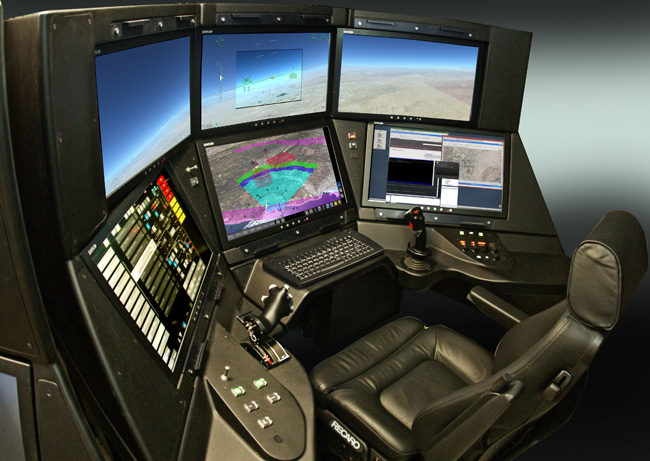
General Atomics Aeronautical Systems Inc (GA-ASI) has successfully demonstrated the command of the Predator C Avenger stealth drone from a new, Advanced Cockpit Ground Control Station’s (GCS). Defense Update reports.
“This flight paired our most advanced GCS with our most advanced aircraft”, said Frank W. Pace, president, Aircraft Systems Group, GA-ASI. “Since 1994, our GCS have amassed over two million flight hours. The Advanced Cockpit is the next logical step in GCS progression. Our objective with this GCS is to fully satisfy customer interoperability requirements, enabling any GA-ASI RPA to be flown from the system.”
“Advanced Cockpit’s wrap-around visual display and multi-dimensional moving map dramatically increases situational awareness, while the integrated digital checklist decreases pilot workload,” said Jason McDermott, the test pilot who successfully handed off control of Avenger from GA-ASI’s legacy GCS to the Advanced Cockpit and controlled the flight during a 3-hour mission. “The combination of these unique features greatly increases the ease and simplicity of mission planning, reduces pilot workload, thereby increasing flight safety.” The flight occurred November 15, 2012 at the company’s Gray Butte Flight Operations Facility in Palmdale, Calif,
“Advanced Cockpit’s wrap-around visual display and multi-dimensional moving map dramatically increases situational awareness, while the integrated digital checklist decreases pilot workload,”
The Advanced Cockpit GCS features intuitive interfaces designed to make hazardous situations easier to identify, enhancing safety and improving the pilot’s reaction time and decision-making processes. Its ergonomic human-machine interface significantly improves situational awareness and reduces workload so the pilot can more effectively and efficiently accomplish his or her mission.
The flight test was conducted under a Congressionally-directed, U.S. Air Force (USAF)-supported program to demonstrate was to demonstrate how the new cockpit’s open systems’ software architecture adapts for other RPA operations. In 2011 the system successfully flew the MQ-1 Predator over a three-month period and, in April 2012, the Advanced Cockpit flew the SARC-1 UAS under a jointly funded company effort with Strategic Simulation Solutions. This effort demonstrated the system’s ability to control third party RPA. This summer, the Advanced Cockpit is scheduled to fly Predator B/MQ-9 Reaper.
GA-ASI designed the Advanced Cockpit GCS to enable interoperability with all USAF RPA, in accordance with the U.S. Air Force’s Unmanned Aircraft System Command and Control Initiative and the U.S. Department of Defense’s vision for GCS interoperability and commonality, as outlined by the Office of the Secretary of Defense’s Unmanned Control Segment Working Group.
Source: Defense-Update


















